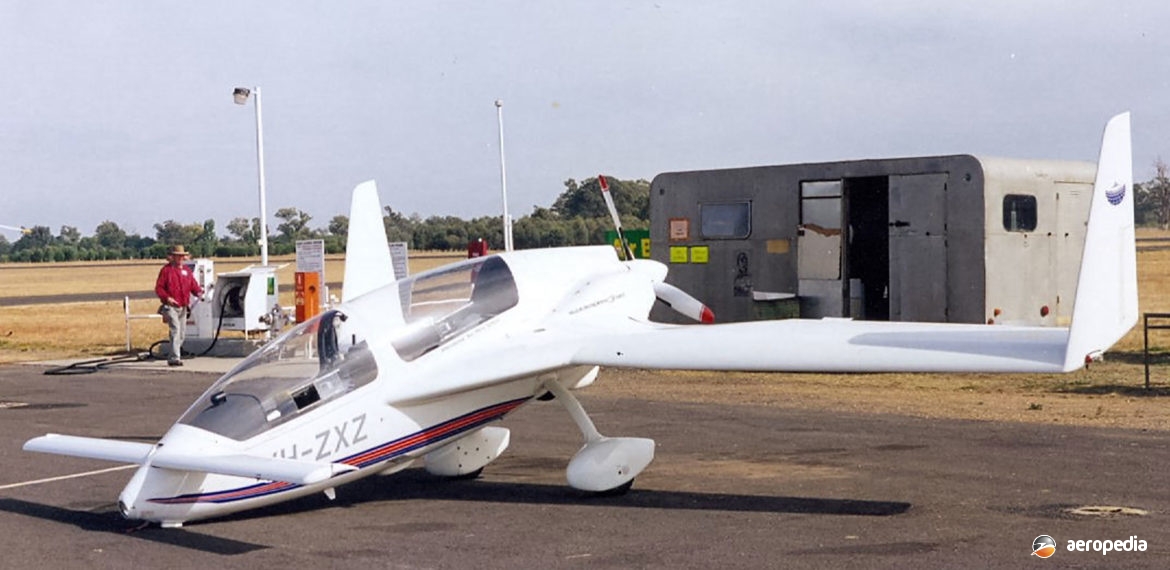Photograph:
Gyroflug SC-01 Speed Canard VH-ZXZ (c/n S.43) at Mangalore, VIC in 1998 (David C Eyre)
Country of origin:
Germany
Description:
Two-seat high-performance light sport aircraft
Power Plant:
One 119 kw (160 hp) Lycoming O-320-D1A four-cylinder horizontally-opposed air-cooled engine
Specifications:
- Wingspan: 7.71 m (25 ft 3 in)
- Length: 4.7 m (16 ft 4 in)
- Height: 1.803 m (6 ft 3 in)
- Wing area: 7.84 m² (84.39 sq ft)
- Never exceed speed: 365 km/h (227 mph)
- Max speed at sea level: 290 km/h (180 mph)
- Cruising speed at 75% power at 2,225 m (7,300 ft): 281 km/h (175 mph)
- Rate of climb: 335 m/min (1,100 ft/min)
- Service ceiling: 5,639 m (18,500 ft)
- Range: 1,065 km (662 miles)
- Fuel capacity: 160 litres (62 Imp gals)
- Take-off roll: 350 m (1,148 ft)
- Take-off distance over 15 m (50 ft) obstacle: 540 m (1,772 ft)
- Landing roll: 300 m (984 ft)
- Landing distance over 15 m (50 ft) obstacle: 700 m (2,300 ft)
- Empty weight: 443 kg (977 lb)
- Loaded weight: 715 kg (1,576 lb)
History:
The Speed Canard was designed and developed by Gyroflug-FFT MbH at Menges on the River Danube and placed in small-scale production. Inspired by Bert Rutan’s Vari Eze and Long Ez, which were always intended to be homebuilts, the Speed Canard was for factory manufacture. The wings and fuselage were made of fibreglass epoxy composite, the cabin being a copy of the Grob Twin II sailplane forward fuselage. The airframe was rated for +4.2G and –2.2G.
Gyroflug Ingenieur GmbH of Ludwigsburg was formed by Peter Krauss and Wolfgang Schiller who carried out a market survey which showed considerable interest in the project. An agreement was reached with Glaser-Dirks Flugzeugbau of Bruchsal and the prototype was built in the Glaser-Dirks factory. Some delay was caused to the project when Peter Krauss died in an aircraft accident. The prototype D-EEEX (c/n A-1) was flown for the first time on 2 December 1980 at Oberpfaffenhofen by Helmut Laurson. However, flight testing revealed the aircraft at that stage was not suitable for series production and some re-design was necessary.
Following re-design and rebuild the aircraft flew again on 10 July 1981 and the designed flight performance was achieved. In 1981 new moulds were prepared and a second airframe, a non-flying example for static testing, was completed. The second flying aircraft D-EEEW (c/n A-3) was flown on 17 April 1983. An exhaustive flying program was then carried out and German Type Certification was received, making it the first certificated GFRP canard to attain series production. During the testing the aircraft achieved 700 operational hours, with 1,100 take-offs in four years of testing. The second test aircraft flew 500 hours with 1,000 take-offs in 28 months.
The first pre-production aircraft D-EELZ (c/n A-4) was delivered in February 1984 and at that time the Company moved to Baden-Oos airfield near Baden-Baden. First export customer was in Zurich, where HB-UCS was delivered. The aircraft had an amazing range, an example of the SC-01B-160 being capable of flying up to 1,600 km (994 miles), ie from London, UK to Frankfurt, Germany and return. An interesting part of the design was the twin rudders operated independently, allowing both rudders to be deflected outwards simultaneously, cancelling each other’s yaw and also acting as airbrakes.
The aircraft were built to order and the production rate was about one aircraft a month, total production reaching 160 aircraft.
The Company was acquired by the Justus Dornier Group in 1984 and moved to Mengen. The Company in the late 1980s was planning to develop the design to four-seat configuration to meet the Mooney and Beech Bonanza market, probably fitting it with a Porsche engine in the 149 kw to 186 kw (200 hp to 250 hp) class. This aircraft was to be known as the E-401 but was abandoned in about 1987.
In 1988 a Speed Canard was used for testing Litton’s Advanced Tactical Surveillance System. The Company was renamed FFT (Gesellschaft fur Flugzeug-und Faserverbund-Technologie MbH) in 1990 but ceased trading on 31 December 1992. The Company was also involved in the development of the FFT Eurotrainer 2000, of which one example was eventually built.
Engines fitted varied from the 87 kw (116 hp) Lycoming O-235 up to the 119 kw (160 hp) Lycoming O-320 and, with the latter, cruising at 1,524 m (5,000 ft) at 75 per cent power, a true airspeed of 278 km/h (172 mph), was available. Useful load was 272 kg (600 lb).
First of the type seen in this region was G-FLUG (c/n S.43) imported from the United Kingdom in May 1997 and assembled at Parafield, SA, later becoming VH-ZXZ. On 19 October 2004 the aircraft departed Bundaberg, QLD on a private flight to Parafield, SA, with a planned refuelling stop at Bourke, NSW. In the St George area of Queensland the pilot radioed he was feeling unwell and was having difficulty lining up on the St George runway. The aircraft later impacted terrain 20 km south-west of St George, killing the pilot and destroying the aircraft.

